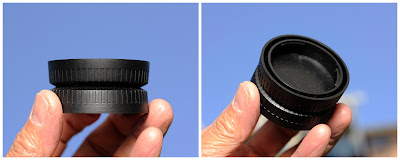 |
| Photo Source: Click here. |
Order Up: My compact lens quest started with the Meike 28mm F 2.8 manual focus copy of the Fuji 27mm F 2.8 lens. Its angle of view is very close to equaling the 42mm lens of my old Olympus 35 SP. The Meike became a frequent fixture on my morning walk camera, and very compact once I attached a Fuji lens hood. Continuing on the compact theme, my next acquisition was a Laowa 10mm F 4.0 cookie lens. I've used this lens almost as much as the longer Meike, and really like its extremely wide 109 degree angle of view.
 |
| Buy yours here. |
With three pancake lenses to carry I wanted to find a way to store them safely while gamboling about in a subject-rich environment. The belt pack I'm using to tote my Fuji X-E1 about has a padded partition that will accommodate two of these compact lenses, while the other compartment can hold the body with the third lens mounted. I would like to store two lenses so they won't rub against one another.
I remember reading about a trick where two rear lens caps were glued together, allowing two lenses to be joined at the mounts. This will prevent unnecessary rubbing while keeping both mounts clean and safe.
A search on eBay uncovered multiple vendors who sell third-party rear lens caps for a trifle, so I bought a handful for a trifle. I took two and used a hand-held grinder to rough up the contact surfaces for better adhesion. I then mixed up some 2-part epoxy, spread a dollop on the contact surfaces, and pressed the two caps together. I then pressed them into the corner of a square-bottomed box so they would be properly aligned and parallel with each other when the epoxy cured.
Here you see two pancakes, the 50mm and the 28mm, joined by the two rear lens caps I glued together. While the two stacked lenses (28mm F2.8 and 50mm F2.0) are about 1" taller than a 7artisans 55mm F 1.4, my original manual focus "long prime", this conjoined pair is compact enough to fit into a largish fanny pack that has become my carry-all when I'm in a manually focused, shoot-for-fun mood.
You'll notice that I've installed Cat Labs Focusing Tabs on all three of these lenses. I really like how I now have a tactile way to insure I'm rotating the focusing ring and not inadvertently messing with the aperture. While the tabs don't have the panache of the metal tabs found on the Leitz lenses, they have certainly earned their place in my kit.
Future Experiments: The 50mm is something of an unknown performer, as I haven't felt compelled to attach it to a body and use if exclusively for a time. This may be academic, since the 10mm cookie has been my favorite lens for capturing wide vistas with lots of blue sky in the background. I think I'm finally getting a good sense for what that little lens can do, and feeling comfortable with the short working distances. And now that I will occasionally pull out a polarizing filter, it seems most at home on the 10.
* After posting, I was reminded of the collapsible Leitz lenses are more compact when collapsed, and the non-collapsible Hektor 28 mm 6.3, which is flatter still.

